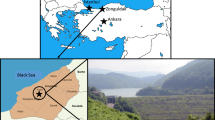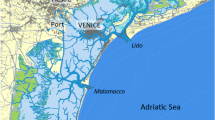Abstract
In this paper, the scouring around a triad series of vertical bridge piers located in a bend is investigated using SSIIM software. To this end, some of the most essential parameters such as the relative radius and the bridge pier position in both transverse and longitudinal directions to the flow have been examined. Then the bed topography variations have been detected within a flume. It is worth mentioning that the experiments have been conducted in a 180-degree sharp bend in the presence of the bridge piers. The available experimental results were used to ensure correctness of the simulated output data. Accordingly, it is evident that the simulated model not only is capable of estimating the amount of the maximum scour and sedimentation but also can effectively predict their position using an experimental model. Based on the results, it is indicated that the maximum scour depth is reported in the case of the bridge pier transverse to the flow installed at the 60-degree position of the bend with a relative radius of 5. Under these circumstances, the maximum depth of scour is evaluated to be 1.14 times the depth of flow at the beginning of the bend. Also, the maximum volume of scour around bridge piers has been detected in this case.

















Similar content being viewed by others
Abbreviations
- SSIIM:
-
The numerical model for calculating water and sedimentation in channel
- CFD:
-
Computational fluid dynamics
- R :
-
The central curvature radius of the bend
- B :
-
The channel width
- R/B :
-
The relative curvature radius
- Q :
-
The flow discharge
- D :
-
The pier diameter
- d :
-
The distance between the piers
- Y :
-
The upstream flow depth
- Z :
-
The bed topography variations
- θ :
-
The angles from the beginning of the bend
- U :
-
The velocity component
- k :
-
The turbulent flow kinetic energy
- P :
-
Total pressure
- a :
-
The reference area equivalent to roughness height
- D 50 :
-
The average sediment diameter
- g :
-
Acceleration of gravity
- ρ s :
-
Sediment density
- ρ w :
-
Water density
- τ :
-
Bed shear stress
- τ C :
-
Critical bed shear stress
- \(\delta_{ij}\) :
-
Kronecker delta
- \(\varepsilon\) :
-
The turbulent flow kinetic energy loss
- υ :
-
Water kinematic viscosity
- υ T :
-
Vortex viscosity
- C bed :
-
Near bed suspended particles concentration
- q b :
-
Bed load
- \(d_{{{\text{s}}_{1} \max }}\) :
-
The maximum scour depth around piers
- \(d_{{{\text{s}}_{2} \max }}\) :
-
The maximum scour depth of the second scour hole
- h max :
-
The maximum sedimentation height
- L :
-
The length of the rectangle surrounding the main scour hole
- W :
-
The width of the rectangle surrounding the main scour hole
- A :
-
The main scour hole area
- V :
-
The main scour hole volume
References
Akib S, Basser H, Karami H, Jahangirzadeh A (2014) Retrofitting of bridge piers against the scour damages: case study of the Marand-Soofian route bridge World Academy of Science, engineering and technology. Int J Civ Archit Sci Eng 8:56–60. https://doi.org/10.5281/zenodo.1336432
Asadollahi M, Vaghefi M, Tabib nejad Motlagh MJ (2019) Experimental and numerical comparison of flow and scour patterns around a single and triple bridge piers located at a sharp 180 degrees Bend. Scientia Iranica. https://doi.org/10.24200/SCI.2019.5637.1391
Asadollahi M, Vaghefi M, Akbari M (2020) Effect of the position of perpendicular pier groups in a sharp bend on flow and scour patterns: numerical simulation. J Braz Soc Mech Sci Eng 42(8):1–15. https://doi.org/10.1007/s40430-020-02503-2
Azizi S, Farsadizadeh D, Arvanaghi H, Abbaspour A (2016) Numerical simulation of flow pattern around the bridge pier with submerged vanes. J Hyd Struct 2(2):46–61. https://doi.org/10.22055/JHS.2016.12856
Basser H, Cheraghi R, Karami H, Ardeshir A, Amir mojahedi M, Akib S, Shamshirband S, (2015) Modeling sediment transport around a rectangular bridge abutment. Environ Fluid Mech 15(6):1105–1114. https://doi.org/10.1007/s10652-015-9398-z
Ben Mohammad Khajeh Sh, Vaghefi M (2020) Investigation of abutment effect on scouring around inclined pier at a bend. J Appl Water Eng Res. https://doi.org/10.1080/23249676.2020.1761898
Ben Mohammad Khajeh Sh, Vaghefi M, Mahmoudi A (2017) The scour pattern around an inclined cylindrical pier in a sharp 180-degree bend: an experimental study. Int J River Basin Manag 15(2):207–218. https://doi.org/10.1080/15715124.2016.1274322
Bozkus Z, Yildiz O (2004) Effects of inclination of bridge piers on scouring depth. J Hyd Eng 130(8):822–827
Ehteram M, Meymand AM (2015) Numerical modeling of scour depth at side piers of the bridge. J Comput Appl Math 280:68–79. https://doi.org/10.1016/j.cam.2014.11.039
Elsaeed GH (2011) Validating SSIIM 3-D numerical model to calculate local scour around bridge piers. Int J Acad Res 3(3):501–505
Elsebaie IH (2013) An experimental study of local scour around circular bridge pier in sand soil. Int J Civ Environ Eng 13(1):23–28
Ezzeldin RM (2019) Numerical and experimental investigation for the effect of permeability of spur dikes on local scour. J Hydro inform 21(2):335–342. https://doi.org/10.2166/hydro.2019.114
Fael C, Lança R, Cardoso A (2016) Effect of pier shape and pier alignment on the equilibrium scour depth at single piers. Int J Sedim Res 31(3):244–250. https://doi.org/10.1016/j.ijsrc.2016.04.001
Ghobadian R, Basiri M (2016) The effect of downstream curved edge on local scouring at 60-degree open channel junction using SSIIM1 model. Ain Shams Eng J 7(2):543–552. https://doi.org/10.1016/j.asej.2015.06.001
Graf WH, Istiarto I (2002) Flow pattern in the scour hole around a cylinder. J Hydraul Res 40(1):13–20. https://doi.org/10.1080/00221680209499869
Hamidi A, Siadatmousavi SM (2017) Numerical simulation of scour and flow field for different arrangements of two piers using SSIIM model. Ain Shams Eng J 9(4):2415–2426. https://doi.org/10.1016/j.asej.2017.03.012
Hämmerling M, Walczak N, Nowak A, Mazur R, Chmist J (2018) Modelling velocity distributions and river bed changes using computer code SSIIM below sills stabilizing the riverbed. Pol J Environ Stud 28(3):1165–1179. https://doi.org/10.15244/pjoes/85224
Johnson PA, Dock DA (1998) Probabilistic bridge scour estimates. J Hyd Eng 124(7):750–754. https://doi.org/10.1061/(ASCE)0733-9429(1998)124:7(750)
Karimi N, Heidarnejad M, Masjedi A (2017) Scour depth at inclined bridge piers along a straight path: a laboratory study. Eng Sci Technol Int J 20(4):1302–1307. https://doi.org/10.1016/j.jestch.2017.07.004
Khayyun TS, Mouhamed NH (2018) Three dimensional modeling of sediment transport upstream of Al- Betera regulator-Iraq. J Eng Sustain Dev 22(5):215–238. https://doi.org/10.31272/jeasd.2018.5.16
Leschziner MA, Rodi W (1979) Calculation of strongly curved open channel flow. J Hyd Div 105(10):1297–1314
Mohamed YA, Nasr Allah TH, Abdel Aal GM, Awad AS (2015) Investigating the effect of curved shape of bridge abutment provided with collar on local scour, experimentally and numerically. Ain Shams Eng J 6(2):403–411. https://doi.org/10.1016/j.asej.2014.10.011
Olsen NRB (2014) A three-dimensional numerical model for simulation of sediment movement in water intakes with multi-block option. Department of Hydraulic and Environmental Engineering, Norwegian University of Science and Technology, User's manual, Norway, pp172–183
Olsen NRB, Melaaen MC (1993) Three-dimensional calculation of scour around cylinders. J Hyd Eng 119(9):1048–1054. https://doi.org/10.1061/(ASCE)0733-9429(1993)119:9(1048)
Rasaei M, Nazari S, Eslamian S (2020) Experimental and numerical investigation the effect of pier position on local scouring around bridge pier at a 90° convergent bend. J Hyd Struct 6(1):55–76. https://doi.org/10.22055/JHS.2020.32753.1134
Richardson JE, Panchang VG (1998) Three-dimensional simulation of scour-inducing flow at bridge piers. J Hyd Eng 124(5):530–540. https://doi.org/10.1061/(ASCE)0733-9429(1998)124:5(530)
Roulund A, Sumer BM, Fredsoe J, Michelsen J (2002) 3-D numerical modeling of flow and scour around a pile. In: First international conference on scour of foundations international society of soil mech and foundations
Salahedin TM, Imran J, Chaudhry MH (2004) Numerical modeling of three-dimensional flow field around circular piers. J Hyd Eng 130(2):91–100. https://doi.org/10.1061/(ASCE)0733-9429(2004)130:2(91)
Tseng MH, Yen CL, Song CC (2000) Computation of three-dimensional flow around square and circular piers. Int J Numer Meth Fluids 34(3):207–227. https://doi.org/10.1002/1097-0363(20001015)34:3%3c207::AID-FLD31%3e3.0.CO;2-R
Vaghefi M, Safarpoor Y, Akbari M (2017) Numerical comparison of the parameters influencing the turbulent flow using a T-shaped spur dike in a 90° bend. J Appl Fluid Mech 10(1):231–241. https://doi.org/10.18869/acadpub.jafm.73.238.26175
Vaghefi M, Tabib Nazhad Motlagh MJ, Sh HS, Moradi S (2018) Experimental study of bed topography variations due to placement of a triad series of vertical piers at different positions in a 180° bend. Arab J Geosci 11(5):102. https://doi.org/10.24200/SCI.2019.5637.1391
Vaghefi M, Solati S, Abdi Chooplou Ch (2020) The effect of upstream T-shaped spur dike on reducing the amount of scouring around downstream bridge pier located at a 180° sharp bend. Int J River Basin Manag. https://doi.org/10.1080/15715124.2020.1776306
Wang H, Tang H, Liu Q, Wang Y (2016) Local scouring around twin bridge piers in open-channel flows. J Hyd Eng 142(9):06016008. https://doi.org/10.1061/(ASCE)HY.1943-7900.0001154
Yen CL, Lai JS, Chang WY (2001) Modeling of 3D flow and scouring around circular piers. Proc Natl Sci Council Roc (A) 25(1):17–26
Author information
Authors and Affiliations
Corresponding author
Rights and permissions
About this article
Cite this article
Vaghefi, M., Moradi, S. & Abdi Chooplou, C. Numerical Study of Bed Topography Variations Owing to Placement of Triad Series of Vertical Bridge Piers Installed in a 180-degree Bend with Different Relative Radii Using SSIIM Numerical Model. Iran J Sci Technol Trans Civ Eng 45, 1971–1988 (2021). https://doi.org/10.1007/s40996-020-00559-7
Received:
Accepted:
Published:
Issue Date:
DOI: https://doi.org/10.1007/s40996-020-00559-7




